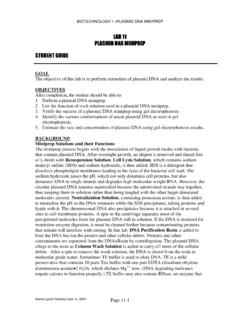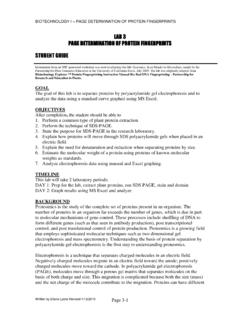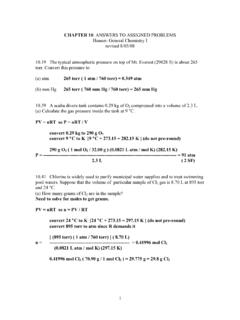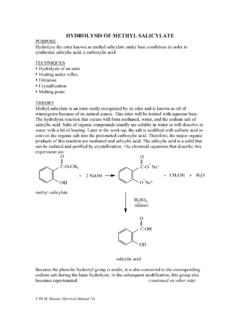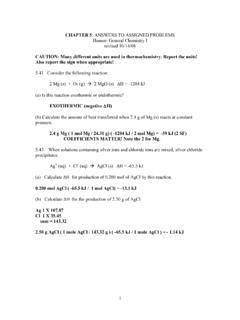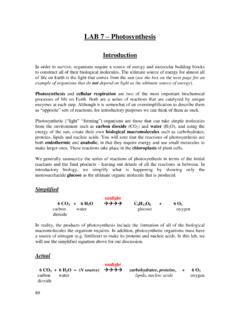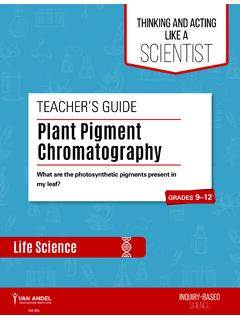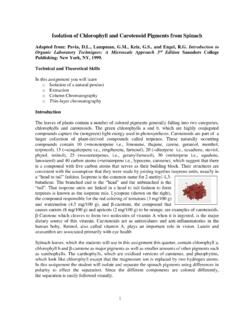Transcription of COLUMN CHROMATOGRAPHY EXTRACTION OF PIGMENTS …
1 S' 08 v2 COLUMN CHROMATOGRAPHY EXTRACTION OF PIGMENTS FROM SPINACH (THIS LABORATORY PROCEDURE WAS PROVIDED BY Dr. V. WAGHULDE.) Purpose: To separate plant PIGMENTS from spinach leaves using COLUMN CHROMATOGRAPHY . The leaves of plants contain a number of colored PIGMENTS generally falling into two categories, chlorophylls and carotenoids. Chlorophylls a and b are the PIGMENTS that make plants look green. These highly conjugated compounds capture the (non-green) light energy used in photosynthesis. Carotenoids are part of a larger collection of plant-derived compounds called terpenes.
2 These naturally occurring compounds contain 10, 15, 20, 25, 30 and 40 carbon atoms, which suggest that there is a compound with five carbon atoms that serves as their building block. Their structures are consistent with the assumption that they were made by joining together isoprene units, usually in a "head to tail" fashion. Isoprene is the common name for 2-methyl-1,3-butadiene. The branched end is the "head" and the unbranched is the "tail." That isoprene units are linked in a head to tail fashion to form terpenes is known as the isoprene rule.
3 Carotenoids are tetraterpenes (eight isoprene units). Lycopene, the compound responsible for the red coloring of tomatoes and watermelon, and -carotene, the compound that causes carrots and apricots to be orange, are examples of carotenoids. -Carotene is also the coloring agent used in margarine. When ingested, -carotene is cleaved to form two molecules of vitamin A and is the major dietary source of this vitamin. Vitamin A, also called retinol, plays an important role in vision. -Carotene Spinach leaves contain chlorophyll a and b and -carotene as major PIGMENTS as well as smaller amounts of other PIGMENTS such as xanthophylls; these are oxidized versions of carotenes and phenophytins, which look like chlorophyll except that the magnesium ion (Mg+2) has been replaced by two hydrogen ions (H+).
4 S' 08 v2 In this experiment we will isolate and separate the spinach PIGMENTS using differences in polarity to effect the separation. Since the different components are colored differently, we can follow this separation visually. Notice that since -carotene is a hydrocarbon it is very nonpolar. Both chlorophylls contain C O and C N bonds (polar groups) and also contain magnesium bonded to nitrogen - forming a bond so polar that it is almost ionic. The structures of the chlorophylls are given below. Both chlorophylls are much more polar than -carotene.
5 If you look carefully you can see that the two chlorophylls differ only in one spot. Chlorophyll a has a methyl group (-CH3) in a position where chlorophyll b has an aldehyde (-CHO); look on left side of structures below. This makes chlorophyll b slightly more polar than chlorophyll a. After we isolate the pigment mixture from the leaves in a hexane solution, we will use the difference in polarity to separate the various PIGMENTS using COLUMN CHROMATOGRAPHY . We will analyze the original extract and the pigment fractions using thin layer CHROMATOGRAPHY , which also separates based on polarity.
6 S' 08 v2 COLUMN CHROMATOGRAPHY is performed by packing a glass tube with an absorbent as shown in (Survival Manual p. 243-Figure ). A COLUMN may be packed 'wet' by pouring solvent-adsorbent slurry into the tube, or 'dry' by filling it with dry adsorbent. The mixture to be purified is then dissolved in a small amount of the appropriate solvent and added carefully to the top of the COLUMN , so as not to disturb the packing. The COLUMN is developed by adding more solvent to the top and collecting the fractions of eluent that come out of the bottom in separate test tubes.
7 For 'flash' COLUMN CHROMATOGRAPHY , moderate air pressure is used to push the solvent through the COLUMN . The success of the separation and the contents of the fractions can be determined by spotting the fractions along with the initial mixture on TLC. A COLUMN may be developed with a single solvent mixture or a with a polarity gradient (a solvent system which gradually increases in polarity.) For example, a COLUMN may be developed first with a low-polarity solvent, such as hexane, and as fractions are collected the developing solvent is changed to 70:30 hexane: acetone, then 50:50 hexane: acetone.
8 (The solvent is changed by adding more to the top of the COLUMN ). A polarity gradient is used for mixtures of compounds with very different polarities. Solvents. A common non-polar solvent for CHROMATOGRAPHY is hexane. It can be used with a variety of polar solvents, some of which are listed below in order of increasing polarity: chloroform, ethyl acetate, methylene chloride, and methanol. NOTE: DO NOT LET THE TOP OF THE COLUMN RUN DRY UNTIL YOU ARE FINISHED. Procedure: mortar and pestle 1. Weigh g of dry spinach leaves. Remove any stems and veins from the leaves before you weigh.
9 2. Using mortar and pestle, grind the spinach leaves to a fine paste by adding 1-2 mL of acetone. If the acetone evaporates, then add an additional 1 mL. 3. Transfer the paste using a Pasteur pipette along with acetone to a centrifuge tube without cap and centrifuge the mixture. 4. Transfer the liquid portion (after centrifuging) using a Pasteur pipette to another centrifuge tube WITH cap. 5. Add 3 mL of hexane and 3 mL of water to the above liquid and cap the centrifuge tube. Mix the contents and centrifuge again. 6. Remove the organic layer using a Pasteur pipette and place it in a clean, dry test tube.
10 7. Repeat steps 5 and 6 with the remaining aqueous layer. Drying organic layer 8. Prepare a drying COLUMN using a short stem Pasteur pipette by carefully pushing a small piece of cotton down to the narrow part. Use a piece of stiff wire or the tip of another pipet to push the cotton in place. S' 08 v2 9. Clamp the pipette with a thermometer clamp onto a ring stand after adding about 1 g of anhydrous sodium sulfate. 10. Pass the organic layer through the COLUMN , draining into your smallest round bottom flask. Rinse the COLUMN with an additional 1-2 mL hexane.
